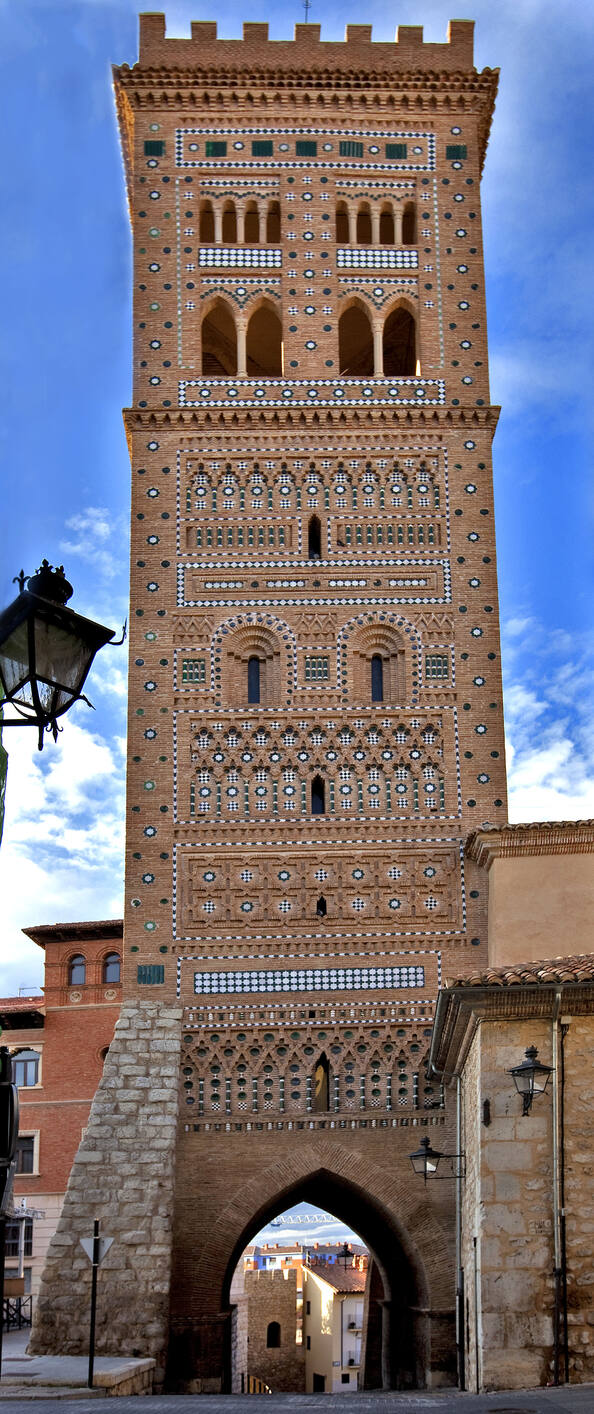Памятники стиля мудехар в Арагоне
Mudejar Architecture of Aragon
The development in the 12th century of Mudejar art in Aragon resulted from the particular political, social and cultural conditions that prevailed in Spain after the Reconquista. This art, influenced by Islamic tradition, also reflects various contemporary European styles, particularly the Gothic. Present until the early 17th century, it is characterized by an extremely refined and inventive use of brick and glazed tiles in architecture, especially in the belfries.
La description est disponible sous licence CC-BY-SA IGO 3.0
Architecture mudéjare d’Aragon
L’apparition au XIIe siècle de l’art mudéjar en Aragon est le fruit de conditions politiques, sociales et culturelles particulières à l’Espagne d’après la Reconquête. Cet art d’influence en partie islamique reflète aussi les différentes tendances européennes qui se sont développées parallèlement, notamment le gothique. Présent jusqu’au début du XVIIe siècle, il se caractérise par un usage extrêmement raffiné et inventif de la brique et des céramiques vernies, en particulier dans les clochers.
La description est disponible sous licence CC-BY-SA IGO 3.0
هندسة أراغون المدجّنة
يُشكّل ظهور الفنّ المدجّن في أراغون في القرن الثاني عشر ثمرة ظروف سياسيّة واجتماعيّة وثقافيّة خاصة بإسبانيا بُعيد الفتح الثاني. ويعكس هذا الفنّ ذات التأثير الإسلامي التوجهات الأوروبيّة المختلفة التي تطوّرت على خطٍ موازٍ وخصوصاً الميول القوطيّة. واستمرّ هذا الفنّ حتى مطلع القرن السابع عشر ومن خصائصه الاستخدام المنمّق والمبتكر لحجر القرميد والخزامة المطليّة خصوصاً في قبب الأجراس.
source: UNESCO/CPE
La description est disponible sous licence CC-BY-SA IGO 3.0
阿拉贡的穆德哈尔式建筑
公元12世纪穆德哈尔艺术的发展与收复国土后西班牙当时的政治、社会和文化状况息息相关。这种艺术形式不仅受到了伊斯兰传统的影响,而且还体现出了当时欧洲的风格,特别是哥特式风格。从公元17世纪初一直到现在,这种艺术风格在建筑中,特别是在钟楼建筑中,以创造性地精妙使用砖块和釉面砖而闻名。
source: UNESCO/CPE
La description est disponible sous licence CC-BY-SA IGO 3.0
Памятники стиля мудехар в Арагоне
Развитие в XII в. искусства мудехар в Арагоне явилось следствием политических, социальных и культурных условий, сложившихся в Испании после реконкисты. Это искусство, питавшееся исламскими традициями, отражало также влияние различных современных европейских стилей, прежде всего – готики. Существовавшее до начала XVII в., это искусство характерно крайне изысканным и изобретательным использованием кирпича и глазурованной плитки в архитектуре, особенно при сооружении колоколен.
source: UNESCO/CPE
La description est disponible sous licence CC-BY-SA IGO 3.0
Arquitectura mudéjar de Aragón
La aparición del arte mudéjar en Aragón, hacia el siglo XII, se debió a las peculiares condiciones políticas, sociales y culturales de la España de la Reconquista. Influenciado en parte por el arte islámico, el mudéjar también muestra huellas de las tendencias coetáneas de los estilos arquitectónicos europeos, en particular el gótico. Los monumentos mudéjares –cuya construcción se prolongó hasta principios del siglo XVII– se caracterizan por una utilización sumamente refinada e ingeniosa del ladrillo y la cerámica vidriada, sobre todo en los campanarios.
source: UNESCO/CPE
La description est disponible sous licence CC-BY-SA IGO 3.0
アラゴン州のムデハル様式建造物
スペイン北東部、アラゴン地方南部を占めるテルエル州の州都。12世紀にイスラム勢力を駆逐したアラゴン王国の下に特別に許されて残ったイスラム教徒が、12~17世紀にムデハル様式(キリスト教とイスラム教の2文化の融合形式)の建造物を多数建築した。聖ペドロ、聖サルバドール大聖堂などのほか、特に聖サルバドールの塔では、そのムデハル様式を顕著に見ることができる。source: NFUAJ
Mudejar architectuur van Aragon
De Mudejar kunst ontwikkelde zich in de 12e eeuw in Aragon, als resultaat van de politieke, sociale en culturele omstandigheden die Spanje domineerden na de Reconquista. De kunstsoort werd beïnvloed door de islamitische traditie, maar weerspiegelt ook hedendaagse Europese stijlen, in het bijzonder die van de gotiek. Mudejar kunst was aanwezig tot het begin van de 17e eeuw en uitte zich in de architectuur door een uiterst verfijnd en inventief gebruik van baksteen en geglazuurde tegels, vooral terug te zien in de klokkentorens. De Mudejar kunst van Aragon symboliseert het vreedzame samenleven van de islamitische, christelijke en joodse cultuur en de onderlinge uitwisseling van kennis en ervaringen.
Source : unesco.nl
